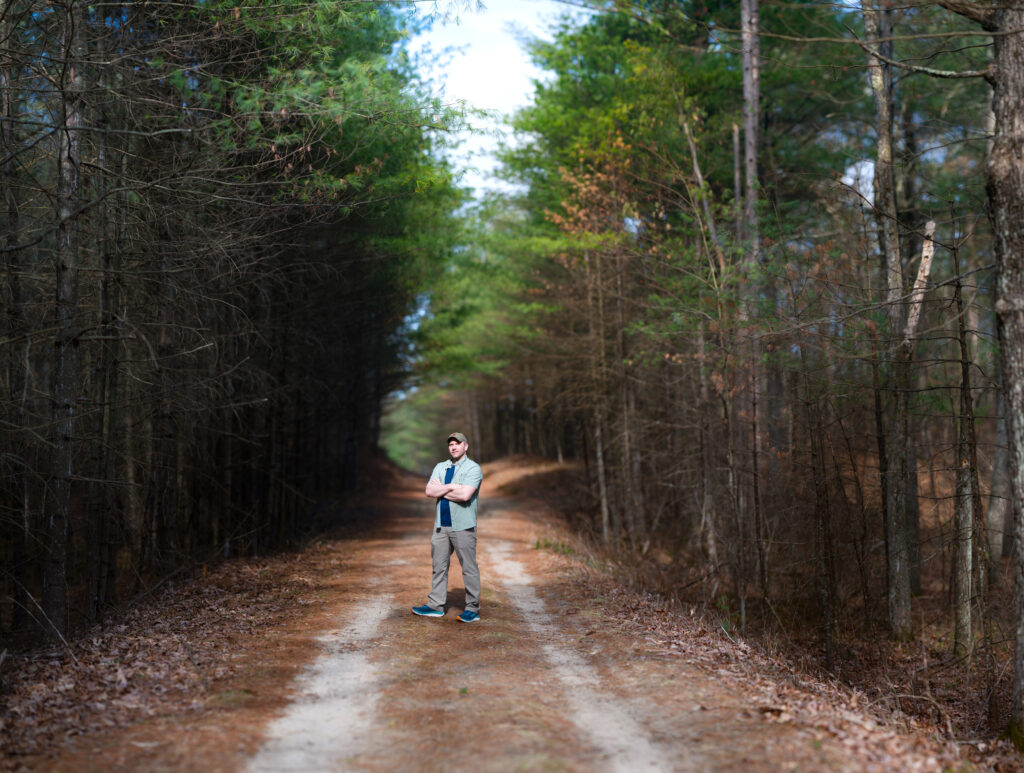Here’s an image of me shot by my wife. If you don’t have a medium format camera, or large format 8×10, you can still create images that don’t look like they were shot on smaller formats. In fact, I doubt this image could have even been created on 8×10 and would have actually needed a larger piece of film.
We created this image by taking multiple photos while I stood still. The camera we used was the Nikon Z8. The lens was the Nikon 105mm f1.4 at f1.4. Many images stitched together gave the look you see in the photograph. This is just a test shot, and I look a bit odd, but done correctly, and with the right lighting, this can produce great results. If you’re going for a shallow depth of field with an environmental portrait, I’m not sure I would trek out an 8×10 view camera while knowing this method exist.
The Art of Bokeh Panoramas (The Brenizer Method): Simulating the Medium Format Look
In the world of digital photography, the pursuit of the “medium format look”—that dreamy, shallow depth of field combined with wide-angle context—has led to creative techniques that push the limits of standard full-frame and APS-C cameras. One such technique is the bokeh panorama, also known as the Brenizer Method, named after photographer Ryan Brenizer who popularized it in the early 2000s.
What is a Bokeh Panorama?
A bokeh panorama is a stitched image composed of multiple photos taken with a fast, wide-aperture lens at a telephoto or portrait focal length. The result is an image with the field of view of a wide-angle lens, but the depth of field of a much longer focal length, producing incredibly shallow focus and creamy background blur—very similar to what you’d see from medium or large format film.
Why It Simulates Medium Format
Medium format cameras (especially film or modern digital systems like the Fujifilm GFX or Hasselblad X series) produce images with:
- Shallow depth of field at wide angles
- High subject separation
- A distinct 3D pop due to their larger sensor size and lens characteristics
A bokeh panorama mimics this by:
- Using a fast lens (e.g., 85mm f/1.4) to get extreme shallow depth of field
- Shooting multiple overlapping frames while keeping the aperture wide open
- Stitching them to simulate the larger image circle and sensor coverage of a medium format system
By the time you crop and merge the multiple exposures, the effective “sensor” becomes much larger than your camera’s sensor, recreating that immersive large-format feel.
How to Shoot a Bokeh Panorama
Equipment Needed:
- A DSLR or mirrorless camera
- A fast prime lens (e.g., 85mm f/1.8, 50mm f/1.4, 135mm f/2)
- Tripod (optional but helpful)
- Lightroom and Photoshop (or another stitching software)
Step-by-Step Shooting Guide:
- Set Your Aperture Wide Open
- Use your lens at its widest aperture (f/1.4 to f/2.8) to maximize background blur.
- Switch to Manual Focus and Exposure
- Lock your focus on the subject and keep it fixed.
- Also lock your exposure settings (shutter speed, ISO, aperture) to maintain consistency.
- Shoot a Grid of Overlapping Images
- Start with your subject in the center.
- Take a series of photos, panning outward in a grid pattern.
- Overlap each image by at least 30% to aid in stitching.
- Keep the Subject Still
- Since stitching works best when the subject and background don’t move, avoid windy conditions or moving people.
How to Create Bokeh Panoramas in Adobe Lightroom and Photoshop
1. Import and Select Your Images
- Load your images into Lightroom and select the entire set.
2. Apply Consistent Edits
- Make global edits (white balance, contrast, exposure) to one image and sync settings across all selected frames to ensure uniformity.
3. Stitch in Photoshop
- With all images selected, right-click and choose:
Edit In → Merge to Panorama in Photoshop - In the dialog box that appears in Photoshop, select Auto Layout and let it work.
4. Crop and Save
- After Photoshop stitches the image, crop it to remove the empty edges.
- Save the file—it will automatically reappear in Lightroom for final edits.
Tips for Better Results
- Shoot in RAW: Ensures maximum dynamic range and color fidelity.
- Avoid busy backgrounds: Too much detail can confuse stitching algorithms.
- Be precise with your overlaps: Especially around your subject’s edges.
- Practice patience: Stitching large files can be slow and memory-intensive.
Final Thoughts
The Brenizer Method, or bokeh panorama technique, is an incredible way to create the illusion of medium format aesthetics with standard gear. It’s especially popular in portrait photography, where the separation between subject and background creates stunning visual impact. While not a substitute for the dynamic range or tonal depth of actual medium format cameras, it remains a powerful tool in the modern photographer’s creative arsenal.
Click below for larger image:


